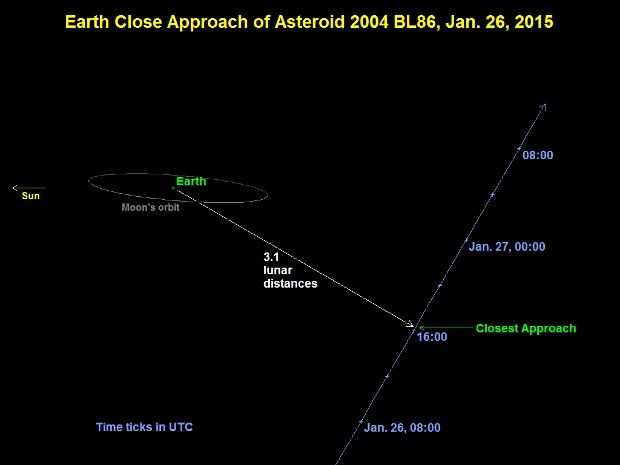Today, January 26, an asteroid is set to fly by Earth. The space rock, dubbed 2004 BL86, will come freakishly close to our planet. Well, at least when compared to the majority of all the other asteroids that have so far visited us.
Fear not, NASA scientists say that the space rock does not in any way represent a threat. In fact, as detailed in the diagram below, the asteroid's path will take it far, far away from Earth. Otherwise put, there is no reason to worry that it might crash into us.
Introducing asteroid 2004 BL86
The asteroid that will visit us this January 26 measures approximately 500 meters (roughly 1,500 feet) across at its widest point. It was discovered back in January, 2004, with the help of a telescope of the Lincoln Near-Earth Asteroid Research (LINEAR) survey in White Sands, New Mexico.
It is expected that the asteroid will make its closest approach at about 16:19 UTC (11:19 EST). At this time, the space rock will be some 1.2 million kilometers (750,000 miles) away from our planet, which is the equivalent of 3 times the distance between Earth and the Moon.
The asteroid will move through the sky from the south to the north, meaning that its path will take it from below Earth's orbit to above. What's really cool about this asteroid visit is the fact that proper astronomers will not be the only ones who will get to have a close look at the space rock.
On the contrary, NASA scientists say that, with the help of a small telescope or maybe just a pair of binoculars, regular folks might be able to observe it traveling through space as well. Yes, today would be a good idea to take some time off work just to gaze at the sky.
Brainiacs hope that, with the help of radar technology, they will manage to map the surface of this asteroid as it flies by our planet. More precisely, researchers expect that this visit will make it possible for them to gain a better understanding of 2004 BL86's shape and makeup.
Today's visit is one for the book
As mentioned, 2004 BL86 measures 500 meters (1,500 feet) across at its widest point. This makes it a pretty impressive space rock, at least as far as size goes. In fact, the asteroid is said to be the biggest celestial body of this kind ever to come within 1.2 million kilometers (750,000 miles) of our planet.
2004 BL86 will get to hold on to this title until 2027, when one other asteroid will fly dangerously close to our planet. As explained by NASA scientists, “The flyby of 2004 BL86 will be the closest by any known space rock this large until asteroid 1999 AN10 flies past Earth in 2027.”

 14 DAY TRIAL //
14 DAY TRIAL // 

